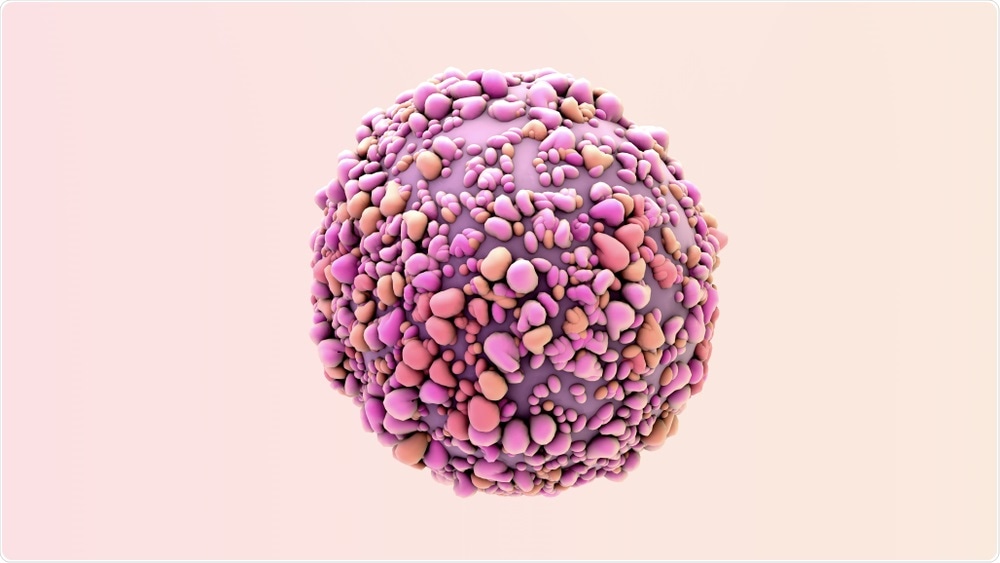A new study has unraveled a genetic vulnerability that exists in almost 10% of all breast cancer tumors, and has discovered a way to target this genetic vulnerability and selectively destroy cancer cells.

Image Credit: Design_Cells/Shutterstock.com
Every year, more than five thousand cases of newly diagnosed breast cancer in the United Kingdom alone is estimated to carry this specific genetic fault—a proportion that is almost twice than that fueled by hereditary modifications, like those in the familiar BRCA genes. The study was published in the scientific journal Nature.
At the University of Oxford, a team of researchers under the guidance of Professor Ross Chapman, and in association with the scientists from the Johns Hopkins University School of Medicine in Baltimore, United States, has identified that cells emerging from a particular subset of human breast cancer tumors, could possibly be destroyed with the help of a chemical that suppresses an enzyme called PLK4. This enzyme is crucial for a specialized part of a cell known as centrosome.
The centrosomes of a cell carry out major functions at the time of cell division, where they control the process in which copies of every chromosome are precisely separated between a pair of identical daughter cells. Generally, cells have safety mechanisms that safeguard them from losing their centrosomes. However, the team found that such breast cancer cells could not live without centrosomes.
The researchers from the University of Oxford contemplated whether the cancer cells they were studying had a genetic modification that rendered them particularly dependent on their centrosomes.
They ultimately focused on one characteristic of these cancer cells—an abnormal repeated stretch of a specific portion on chromosome 17. Called 17q23 amplification, this genetic abnormality is already known to cancer scientists since it is highly prevalent in breast cancer.
Experiments, conducted by Peter Yeow, a graduate student in Dr Chapman’s laboratory, subsequently revealed that a gene called TRIM37 was relatively more active in cells that had 17q23 amplification.
The team then went on to demonstrate that overactive TRIM37 led to faulty centrosomes, which consequently resulted in mistakes during the division of cells. They further speculated that the “daughter” cells born from these abnormal divisions of cells are much more likely to gain new genetic modifications.
We think that what is happening is that if cells acquire too many copies of TRIM37, the normally very carefully orchestrated process of cell division goes haywire, which in turn leads to our genomes becoming unstable. This kind of genomic instability, where cells acquire all sorts of alterations to their genomes as they divide, is one of the hallmarks of cancer development.”
Ross Chapman, Professor, MRC Weatherall Institute of Molecular Medicine, Oxford University
This implies that cells that have the 17q23 amplification have a greater chance to become cancerous. But the team revealed that this feature of cancer comes at a cost—the exact same defect causes the cells to fully depend on their centrosomes for the division of cells, a process crucial to the development of tumors.
The research team subsequently showed that this weakness could be manipulated with the help of a drug that targets the PLK4 enzyme and causes cells to lose their centrosomes. They also demonstrated that this therapy destroyed cancer cells that had 17q23 amplification.
It is slightly ironic that the same thing that makes the cells more likely to become cancerous also makes them uniquely vulnerable to losing their centrosomes, but is useful to us as scientists, because it means that we may be able to selectively target this kind of cancer cell in patients without affecting their healthy cells.”
Ross Chapman, Professor, MRC Weatherall Institute of Molecular Medicine, Oxford University
Regrettably, the chemical PLK4 inhibitor that was used by the team to deplete centrosomes in cancer cells is not appropriate for use in patients. But according to the team, this data can be used to look for novel PLK4-targeting drugs that have the same kind of effect.
We’ve found a previously unknown genetic vulnerability in breast cancer, and discovered a means to exploit this vulnerability and selectively kill cancer cells. We now hope that other researchers and pharmaceutical companies can generate new drugs that can target this process, to produce more effective and safer cancer treatments.”
Ross Chapman, Professor, MRC Weatherall Institute of Molecular Medicine, Oxford University
What is equally promising is that such a genetic fault has also been identified in other types of cancer, in addition to breast cancer.
“Virtually any tumor, irrespective of origin, could be targeted if it harbours the 17q23 amplification. This greatly expands the number of patients that stand to benefit from therapies that may emerge from our study,” Yeow concluded.
Source:
Journal reference:
Yeow, Z. Y., et al. (2020) Targeting TRIM37-driven centrosome dysfunction in 17q23-amplified breast cancer. Nature. doi.org/10.1038/s41586-020-2690-1.